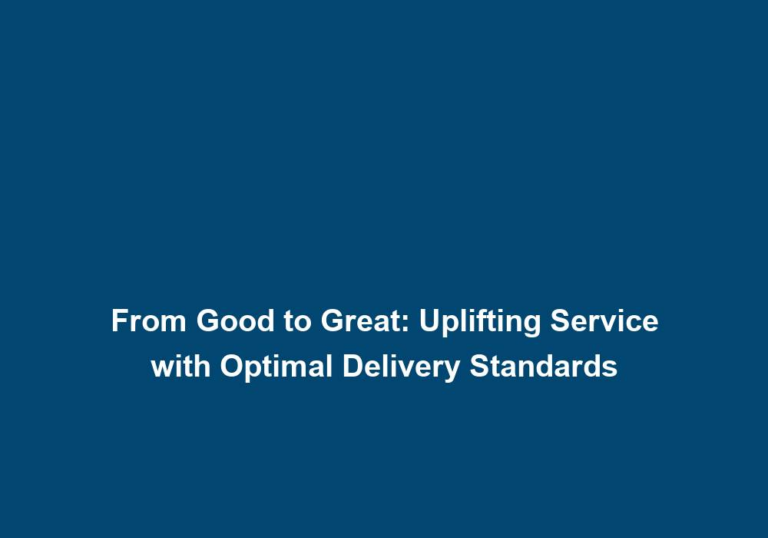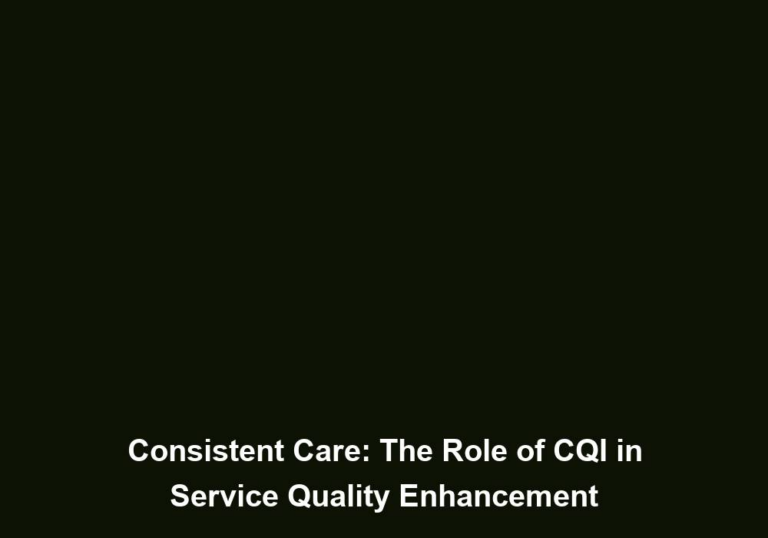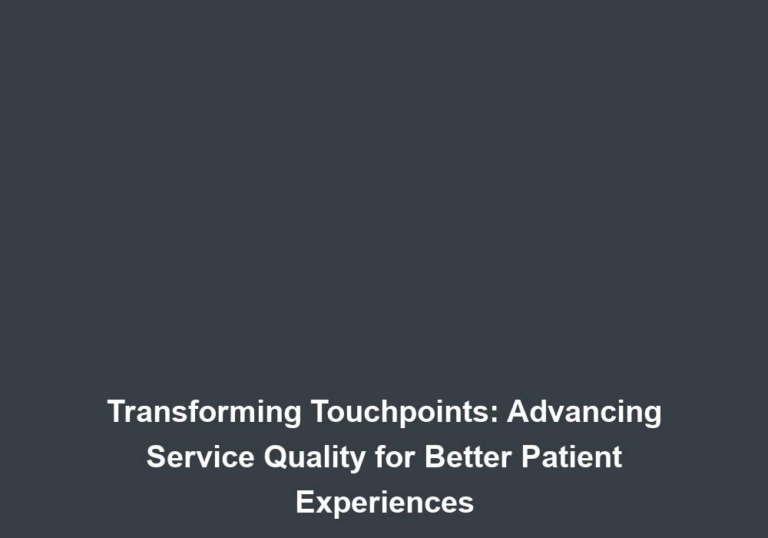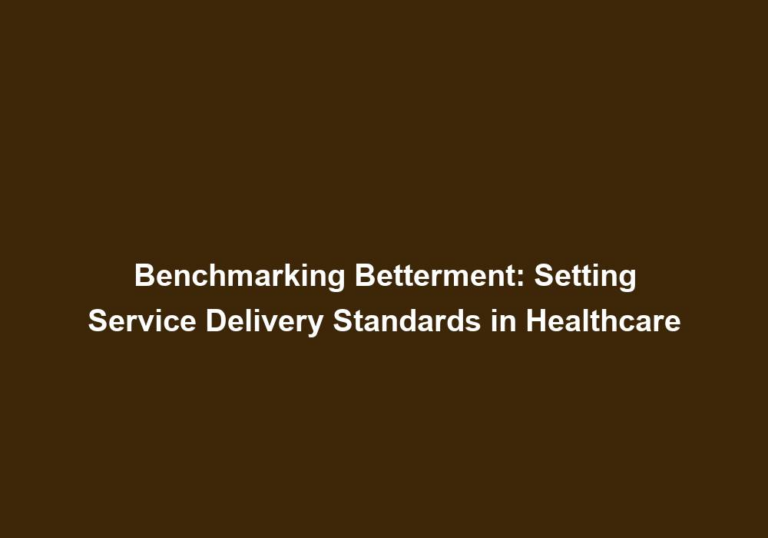Standard Setters: Crafting Service Delivery Standards for Enhanced Care
In today’s rapidly evolving healthcare industry, the delivery of high-quality care is of utmost importance. As the demand for healthcare services continues to grow, it becomes essential for healthcare providers to establish and adhere to service delivery standards. These standards act as a guiding framework, ensuring consistency, efficiency, and enhanced care for patients. This article aims to dive into the significance of standard setters in crafting service delivery standards that elevate the quality of care provided.
Introduction
In today’s healthcare industry, ensuring the delivery of high-quality care is crucial. As the demand for healthcare services continues to rise, healthcare providers must establish and uphold service delivery standards. These standards serve as a comprehensive framework that guides healthcare professionals in delivering consistent and effective care. By adhering to these standards, healthcare providers can prioritize patient safety, improve care coordination, and achieve better health outcomes.
The Role of Standard Setters
Standard setters play a vital role in the healthcare industry by establishing and promoting service delivery standards. They are responsible for developing guidelines, protocols, and best practices that guide healthcare providers in delivering consistent and effective care. These standards cover various aspects of service delivery, including clinical practices, patient safety, ethical considerations, and communication.
Standard setters collaborate with healthcare professionals, regulatory bodies, and industry experts to develop evidence-based guidelines that reflect the latest advancements and best practices in healthcare. They conduct thorough research, analyze data, and consider input from various stakeholders to craft service delivery standards that are relevant, practical, and effective.
Advantages of Service Delivery Standards
Implementing service delivery standards offers numerous advantages to both healthcare providers and patients. Let’s explore some of these benefits in detail:
1. Consistency and Efficiency
Service delivery standards promote consistency in healthcare practices, ensuring that patients receive the same level of care across different providers and settings. By establishing clear protocols and guidelines, standard setters enable healthcare professionals to deliver care efficiently, reducing variations in treatment approaches and improving patient outcomes.
In addition, service delivery standards streamline workflows and processes, optimizing resource allocation and reducing wastage. By ensuring consistent and efficient care delivery, these standards contribute to a more sustainable healthcare system.
2. Enhanced Patient Safety
Patient safety is a top priority in healthcare. Service delivery standards focus on identifying and addressing potential risks, ensuring a safe environment for patients. Standard setters establish safety protocols, infection control measures, and guidelines for medication administration, reducing the likelihood of errors and adverse events.
By adhering to these standards, healthcare providers can proactively identify and mitigate risks, ensuring the well-being of their patients. Standard setters continuously update these standards to incorporate new safety measures and respond to emerging threats, such as infectious diseases or cybersecurity risks.
3. Improved Quality of Care
Crafting service delivery standards allows healthcare providers to continuously assess and improve the quality of care provided. By setting benchmarks and metrics, standard setters encourage healthcare professionals to strive for excellence, leading to enhanced patient satisfaction and better health outcomes.
Service delivery standards promote evidence-based practices, ensuring that healthcare providers stay up-to-date with the latest advancements in their respective fields. By incorporating the latest research and clinical guidelines, standard setters help healthcare professionals deliver the most effective and efficient care to their patients.
4. Facilitates Interdisciplinary Collaboration
Service delivery standards facilitate effective collaboration between different healthcare professionals involved in a patient’s care journey. By establishing clear communication protocols and interdisciplinary guidelines, standard setters promote seamless coordination, leading to improved care coordination and patient experience.
Effective interdisciplinary collaboration enhances the continuity of care, reduces medical errors, and improves patient outcomes. Standard setters encourage healthcare professionals to work as a team, fostering a culture of collaboration and shared decision-making.
5. Supports Regulatory Compliance
Adherence to service delivery standards ensures compliance with regulatory requirements and accreditation standards. Standard setters align their guidelines with industry regulations, helping healthcare providers meet legal and ethical obligations. Compliance with these standards also enhances the reputation of healthcare organizations and instills trust among patients.
By following service delivery standards, healthcare providers demonstrate their commitment to delivering high-quality care and ethical practices. Standard setters collaborate with regulatory bodies to ensure that their guidelines align with existing regulations and address emerging regulatory challenges.
Key Elements of Service Delivery Standards
Crafting effective service delivery standards requires careful consideration of various key elements. Let’s explore some crucial components that standard setters should focus on:
1. Clinical Guidelines and Best Practices
Standard setters must establish evidence-based clinical guidelines and best practices that inform healthcare providers about the most effective and efficient approaches to patient care. These guidelines should encompass various medical specialties, ensuring comprehensive coverage across different healthcare settings.
By providing healthcare professionals with clear and up-to-date clinical guidelines, standard setters enable them to make informed decisions and deliver the highest standard of care. These guidelines cover a wide range of medical conditions, procedures, and treatments, ensuring that healthcare providers have access to the latest evidence-based practices.
2. Patient-Centered Care
Service delivery standards should emphasize patient-centered care, placing the patient’s preferences, needs, and values at the forefront. Standard setters should encourage healthcare providers to involve patients in decision-making processes, promote shared decision-making, and respect individual autonomy.
By prioritizing patient-centered care, standard setters ensure that healthcare providers consider the unique needs and preferences of each patient. This approach fosters a therapeutic alliance between healthcare professionals and patients, leading to improved patient satisfaction and better treatment outcomes.
3. Continuous Quality Improvement
To ensure that service delivery standards remain up-to-date and relevant, standard setters should incorporate mechanisms for continuous quality improvement. Regular evaluation, feedback collection, and data analysis enable standard setters to identify areas for improvement and implement necessary changes to enhance care delivery.
By monitoring key performance indicators, standard setters can assess the effectiveness of their guidelines and identify opportunities for improvement. They collaborate with healthcare providers to collect feedback and analyze data, ensuring that service delivery standards evolve to meet the changing needs of patients and the healthcare industry.
4. Training and Education
Standard setters should emphasize the importance of ongoing education and training for healthcare professionals. By establishing requirements for continuing education, standard setters ensure that healthcare providers stay updated with the latest advancements, evidence-based practices, and emerging technologies.
Continuing education programs help healthcare professionals enhance their knowledge and skills, enabling them to provide the highest quality of care. Standard setters collaborate with educational institutions, professional associations, and industry experts to develop comprehensive training programs that address the evolving needs of healthcare professionals.
5. Ethical Considerations
Service delivery standards should address ethical considerations, such as patient confidentiality, informed consent, and end-of-life care. Standard setters play a vital role in establishing ethical guidelines that promote patient rights, privacy, and dignity.
By incorporating ethical considerations into service delivery standards, standard setters ensure that healthcare providers uphold ethical principles in their practice. These guidelines help healthcare professionals navigate challenging ethical dilemmas and make decisions that prioritize the well-being and autonomy of their patients.
Conclusion
In conclusion, service delivery standards are paramount in the healthcare industry for ensuring consistent, efficient, and high-quality care for patients. Standard setters play a crucial role in crafting these standards, providing guidelines and best practices that promote clinical excellence, patient safety, and ethical considerations. By adhering to service delivery standards, healthcare providers can enhance patient outcomes, improve care coordination, and meet regulatory requirements. As the healthcare industry continues to evolve, standard setters must stay proactive in updating and refining these standards to reflect the latest advancements and address emerging challenges.







